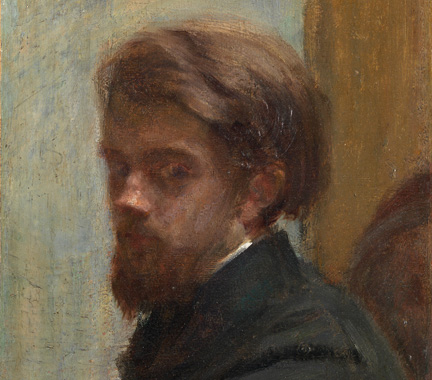 |
| Henri Fantin-Latour, La Lecture, 1877 |
-->
Fantin-Latour. À Fleur de Peau, the title of this exhibition at
the Musée du Luxembourg is—unusually for Paris—spot on. The best works in
Fantin-Latour’s oeuvre as it is presented here are definitely those featuring
skin and flowers. A handful of the most delicate and fascinating works greet us
as we enter the exhibition. A series of small self-portraits show the young Fantin-Latour
in the process of discovering his identity as a painter and the identity of his
canvases. In each, the figure is in different stages of shadow, painted from different
angles of vision, with varying degrees of certainty. The series of
self-portraits c.1858 -1861 at the entrance show his development, a tentative
exploration of painting that is so loose that his uncertainty seems to fill
every stroke. And then towards the end,
in 1859, the Bordeaux self-portrait, depicts Fantin-Latour’s dissolving face as
though he is holding a camera and turns it around on himself. The direct
address to the viewer is startling, particularly as it follows from the face
turned away, unsure of itself.
 |
Henri Fantin-Latour, Autoportrait, 1860
|
In addition
to the early self-portraits, the most striking portraits depict women reading.
A silence surrounds women in their own worlds,
and even when there are two figures in the painting, they never interact. Their
self-absorption isolates them against unremarkable backgrounds. The women in
these works often hold something—a fan, a glove, a paint brush, a pen, as if
their hands are occupied so they are not tempted to touch, or to reach outside
of themselves. The single sitters—both men and women—like Fantin-Latour’s
well-known group portraits tell of the reverence for culture in the modern
world: reading, reflection, absorption, indicating a world in which culture is
always put above sentiment. The alienation and isolation of modern life pervades
these lonely sitters and their apparently lonely lives. In a way, this coldness
makes the intimacy and emotion of the earlier self-portraits even more
remarkable.
 |
| Henri Fantin-Latour, La Lecture, 1870 |
Fantin-Latour
paints the same thing over and over and over again, to the point where, by the end I was
wondering if indeed, his paintings were original. Of course, he was a name on
the French art scene, but he didn’t receive the same acclaim as those he
painted: Rimbaud, Verlaine, Manet and Zola. In this exhibition, we see him
continually referencing/inspired by/copying masters. The famous group portraits
aside, it’s difficult to see what Fantin-Latour brought to the development of
modernist painting in his time. It’s true that the paintings are lovely, but we
have seen the poses before, we know the fall of light on the young artist’s
face from Rembrandt, the profile of a woman against a grey background from
Whistler, the woman reading from Vermeer. In addition, Fantin-Latour seems to
do nothing without a model, suggesting an unswerving attachment to realism.
 |
| Henri Fantin-Latour, Roses dans une couple, 1882 |
That said,
some of the paintings of flowers are beautiful, rich in their colour and filled
with an expression that makes flowers into people. In fact, the flowers are warm and emotional where the human figures are cold and isolated. Unlike the portraits of people, Fantin-Latour
gives the flowers a range of emotions, a look, a knowledge of being observed,
they even might be said to confront the viewer. There is always a flower that
looks out of the portrait and implores the viewer to take pity on it, to notice
it. Like the woman who is in her own world, the one flower is often lonely, in
its own reality. While the portraits are filled with greys and taupes, even the
women’s dresses are muted in their colour, which has the effect of not
distracting from the sentiment of the study, the flowers are radiant. They are
in pinks and whites, purples and their leaves of deep greens, so intense that
they are tempting. They are exquisite, luscious and filled with desire.




No comments:
Post a Comment